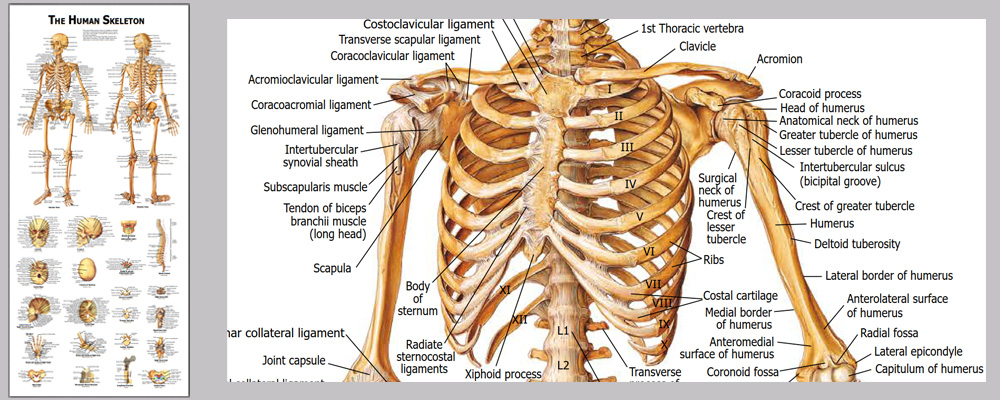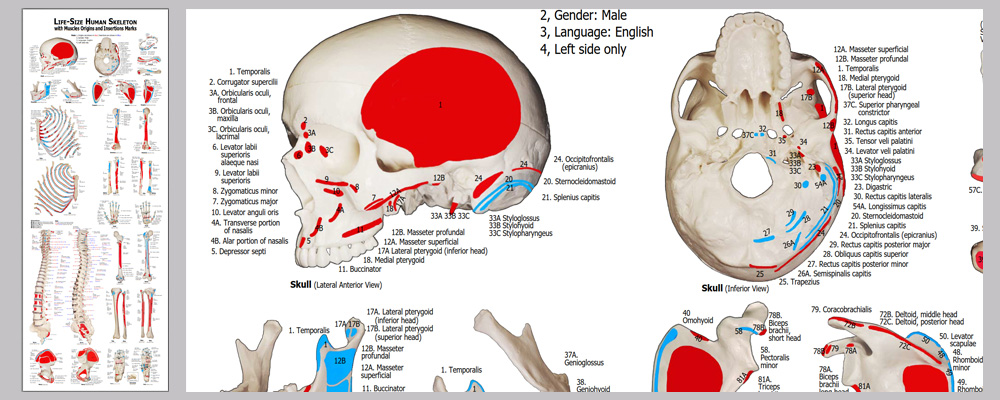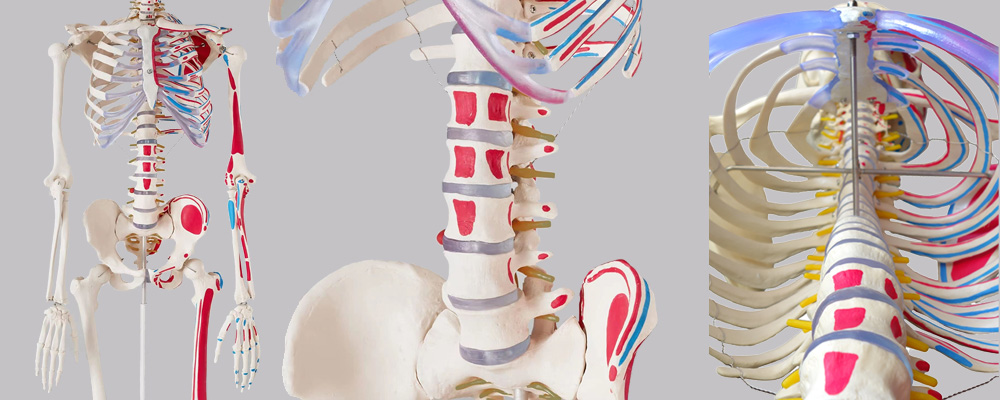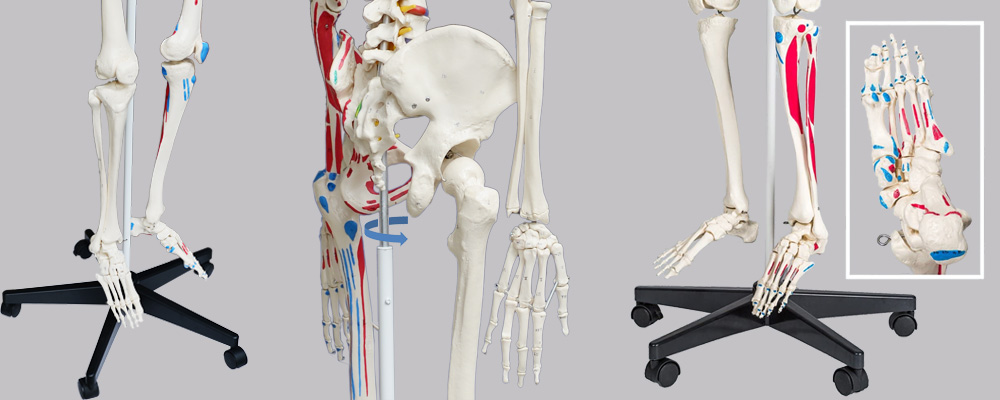anatomical body model
This life size articulated adult human skeleton model is 180cm tall & ideal for teaching / learning the basics of human anatomy. Includes a colorful Human Skeleton chart to show all the detailed structures for reference.Detailed colorful chart with over 630 accurate definitions. Durable and no reflection with matte film covered, 36 * 78cm

Detailed muscles origins and insertions with codes. Durable and no reflection with matte film covered, 100cm * 38cm

Stainless steel wires keep the ribs gaps stable.

2 of 5 casters are lockable.

An overview of JC anatomy advantages: • Hand-painted muscle origins and insertions • Flexible spine and ligaments • Slipped disc between the 3rd and 4th lumbar vertebrae • Protruding spinal nerves and vertebral arteries • 3-part assembled skull with individually inserted teeth • Made from a durable, unbreakable synthetic material • Top quality, life size natural casting • lMultiple Applications -entertainment,entertainment,biology, etc. • lChart - Detailed colorful chart with about 772 accurate definitions. Durable and no reflection with matte film covered, 36 * 78cm • On a stable metal stand with 5 casters (painted white) • Full size dust cover keeps model clean while in storage • Exceptional value for money with a 3 year guarantee • anatomical body model Easy to use - Main joints are movable. Skull, skullcap arms, legs, crus, feet are removable.
| Product name | anatomical body model |
| Place of Origin | Shenzhen China |
| Product Material | PVC, ABS, SST |
| Rib cage | A 5mm dia |
| Human skeleton model life | 12years |
| Surface treatment | Polish. Etched. Texture |
| SUPPORT 24/7 | Contact us 24 hours a day, 7 days a week |
| Size | 82 * 72 * 142 |
| Port | Shenzhen |
| PAYMENT & ORDERING | PayPal account or pay by credit card |
anatomical body model FAQs Guide Are you looking for a quick review guide about anatomical body model? An ultimate FAQs buying guide is available to help you.This guide contains all the information about all the important facts, figures, and various processes regarding anatomical body model. Let’s continue!
2.How many movable joints does anatomical body model have?
3.How much does it weigh and is it easy to carry and maneuver anatomical body model?
4.How many thoracic and lumbar vertebrae are there in the anatomical body model?
5.anatomical body model Can it be used as a teaching aid?
6.About anatomical body model production capacity
7.How much weight can anatomical body model hold?
8.What are the different types of anatomical body model available?
9.How to correctly assemble and utilize a anatomical body model?
10.Can anatomical body model be used in medical research?
11.Is it possible to disassemble different parts of this anatomical body model?
12.anatomical body model Can it be used to show the differences in body structure between children and adults?
13.Does the anatomical body model have movable joints that can show the range of motion of various parts of the human body?
1.Can this anatomical body model be used as a simulation tool for sports training?
The Human skeleton model can definitely be used as a simulation tool for sports training. This model can be used in various ways to simulate different scenarios and movements that are specific to different sports. In conclusion, the Human skeleton model is a versatile tool that can be used to enhance sports training in various ways. It can help athletes and coaches understand and improve technique, prevent injuries, analyze and correct movement patterns, and simulate specific sports movements and scenarios. Thus, it can be a valuable resource for individuals looking to train and improve their performance in sports.
2.How many movable joints does anatomical body model have?
There are approximately 13 movable joints in the human skeleton model, with different types of joints including ball and socket, hinge, pivot, gliding, and saddle joints. These joints allow for a wide range of movements, such as flexion, extension, rotation, abduction, and adduction.
3.How much does it weigh and is it easy to carry and maneuver anatomical body model?
The Net weight is 8.8kgs (19.4lbs). It's easy to move with the 5 castors
4.How many thoracic and lumbar vertebrae are there in the anatomical body model?
There are 12 segments in the thoracic vertebrae, 5 segments in the lumbar vertebraeGenerally, there are 12 thoracic vertebrae and 5 lumbar vertebrae in the human skeleton model. The thoracic vertebrae are located in the middle region of the spine, between the cervical vertebrae (neck) and lumbar vertebrae (lower back). They are numbered from T1 to T12, with T1 being the first thoracic vertebra closest to the skull and T12 being the last thoracic vertebra closest to the pelvis. The lumbar vertebrae are located in the lower back region, below the thoracic vertebrae. They are numbered from L1 to L5, with L1 being the first lumbar vertebra closest to the thoracic vertebrae and L5 being the last lumbar vertebra closest to the sacrum (a triangular bone at the base of the spine). However, the specific number of thoracic and lumbar vertebrae may vary slightly from person to person due to individual differences in bone structure. Some people may have 11 or 13 thoracic vertebrae, and 4 or 6 lumbar vertebrae. This is known as a variation or anomaly in the number of vertebrae. .
5.anatomical body model Can it be used as a teaching aid?
Yes, a human skeleton model is a commonly used teaching aid in various academic fields such as anatomy, biology, and medical education. It is an accurate and detailed representation of the human skeleton, providing a visual aid for students to understand and grasp the complexities of the skeletal system.
6.About anatomical body model production capacity
600pcs each month
7.How much weight can anatomical body model hold?
The amount of weight a human skeleton model can hold depends on the materials used to make it and the structural integrity of the model. Generally, a human skeleton model made from plastic or resin can hold up to 5-10 pounds of weight. However, this weight limit may vary depending on the size and design of the model. If the model is designed to be articulated and movable, it may have a lower weight limit as the joints and connections may not be able to support heavy weights. On the other hand, a solid and non-articulated skeleton model made from sturdy materials such as metal or wood may have a higher weight limit of around 20-30 pounds.
8.What are the different types of anatomical body model available?
1. Anatomical Skeleton Models: These models are exact replicas of the human skeletal system and are used for educational and medical purposes. They are typically made of high-quality materials such as plastic or resin and come with detailed labels for each bone, making it easy to identify and study different structures. 2. Disarticulated Skeleton Models: These models consist of individual bones that can be separated from each other. They are often used in classrooms for teaching purposes as they allow students to handle and study each bone individually, facilitating a more hands-on learning experience. 3. Flexible Skeleton Models: These models are made from a flexible material such as rubber or PVC and are designed to mimic the movements of the human body. They are often used in medical training and rehabilitation settings to demonstrate muscle and joint movements. 4. Life-size Skeleton Models: As the name suggests, these models are the same size as an actual human skeleton. They are most commonly used in medical schools and hospitals for teaching and training purposes.
9.How to correctly assemble and utilize a anatomical body model?
When assembling and utilizing a human skeleton model, there are several steps to follow to ensure correct positioning and accurate representation of the skeletal system. Below is a step-by-step guide to properly assemble and utilize a human skeleton model: 1. Gather all the necessary components: The first step is to gather all the pieces of the human skeleton model, which typically includes a skull, rib cage, spinal column, arms, and legs. Make sure that all the pieces are present and in good condition. 2. Identify the bones: Before assembling the skeleton, it’s important to familiarize yourself with the different bones and their names. The skull, for example, has different parts such as the cranium, mandible, and maxilla, while the spinal column consists of the cervical, thoracic, lumbar, sacrum, and coccyx vertebrae. 3. Attach the arms and legs: Next, attach the arms and legs to the skeleton. Start by connecting the arms to the shoulder sockets and then attach the hand bones to the arms using the elbow and wrist joints. For the legs, connect the femur (thigh bone) to the hip socket, followed by the tibia and fibula (lower leg bones), and finally the foot bones.
10.Can anatomical body model be used in medical research?
This model is mainly for displaying the skeleton structure, shapes, position relationship, and simulating joints movements, surface texture of the bones.
11.Is it possible to disassemble different parts of this anatomical body model?
It's easy to disassemble the whole model into some sub-assemblies - Skull, torso, extremities, etc toollessly. The model can be disassembled into more pieces with tools (Not recommended)
12.anatomical body model Can it be used to show the differences in body structure between children and adults?
Yes, a human skeleton model can be used to clearly demonstrate the differences in body structure between children and adults. Here are some specific examples of how a skeleton model can be used to illustrate these differences: Size and proportion: One of the most evident differences between children and adults is their size and proportion. A skeleton model can be used to compare the relative sizes of different bones in a child and adult, such as the skull, spine, and limbs. Children have smaller and more delicate bones compared to adults, and their proportions also differ. For example, the head and skull of a child are proportionally larger to their body compared to an adult. In conclusion, a human skeleton model is an effective educational tool to showcase the differences in body structure between children and adults. Its three-dimensional design and ability to highlight specific bone structures make it an excellent visual aid to help understand the changes that occur during growth and development.
13.Does the anatomical body model have movable joints that can show the range of motion of various parts of the human body?
Yes, the human skeleton model typically has movable joints that can show the range of motion of various parts of the human body. These joints are usually represented by different types of articulations such as ball and socket, hinge, saddle, pivot, and gliding joints, which mimic the movement of the actual joints in the human body. For example, the shoulder joint of a human skeleton model will have a ball and socket structure that allows for a wide range of motion, similar to the shoulder joint in a real human body. This joint is able to rotate 360 degrees and can also move forward, backward, and sideways. Similarly, the elbow joint in a human skeleton model will have a hinge structure that allows for flexion and extension movements, just like the elbow joint in a real human body. This enables the model to accurately demonstrate movements such as bending and straightening of the arm.




